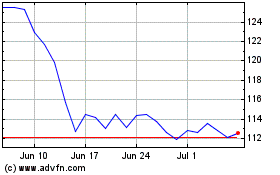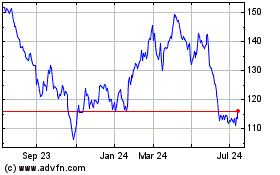Why Car Makers Are Taking On the EV Supply Chain -- Heard on the Street
May 19 2021 - 8:52AM
Dow Jones News
By Stephen Wilmot
Henry Ford invested in steel production and Brazilian rubber.
Today's car makers are getting into batteries and software.
On Tuesday, Chrysler owner Stellantis and iPhone-assembler
Foxconn, also known as Hon Hai Precision Industry, announced a
joint venture to develop in-vehicle software and services. This is
the latest in a long series of moves by auto makers to improve
their supply chains for fully electric, digital vehicles.
Car makers want more control over components central to the
performance and experience of EVs. But they don't have a lot of
experience with those parts, and face many competing claims for
investment. JVs with specialist suppliers offer a solution.
Batteries, the single most expensive EV component, have been the
chief focus so far. General Motors has a JV with South Korean
battery giant LG Chem to make cells; Stellantis and Volkswagen have
deals with European battery companies; Toyota has one with
Panasonic. Ford said last month that it too wanted to get into cell
production, though it hasn't yet detailed how.
The Stellantis-Foxconn JV, called Mobile Drive, applies this
approach to software. It is a logical step, but still an unusual
one. Toyota and Volkswagen, the two largest car makers by sales,
are building up their own software companies. Smaller players such
as Volvo and Renault are leaning heavily on Google owner Alphabet,
which has a version of its Android smartphone operating system for
vehicles.
So-called vertical integration with the supply chain has a long
history in the automotive industry. In the 1920s, Henry Ford built
his own steel mill and even established an ill-fated rubber
plantation in Brazil, encouraged by concerns in Washington about a
British stranglehold on East Asian rubber as the car industry
boomed. With EVs taking off, the U.S. government worries about
Chinese control of the battery supply chain. Tesla has talked about
mining and refining lithium, a key battery component.
There is thus a political side to battery investments in the
U.S. and Europe, where the industry is a pillar of a new industrial
strategy. Amid much anxiety about semiconductor shortages, though,
they are also competitive moves by car makers to secure supplies of
what might become another scarce component. Battery quality is a
third consideration, both in terms of cost and performance. Car
makers are still working out what will differentiate their brands
in a world of EVs, but battery technology -- the equivalent of
their traditional engine know-how -- is a plausible part of the
mix.
Even more important in the competition for EV buyers might be
the so-called user experience, defined increasingly by the touch
screens that are now essential components of car design. This will
be the focus of Mobile Drive. The JV's main benefit for Stellantis
may be access to Foxconn's electronics and software expertise for
brands such as Jeep and RAM.
Stellantis and Foxconn want to sell Mobile Drive to other car
makers, just as GM and LG Chem have pitched their cells to third
parties under the "Ultium" brand. Such ambitions are perhaps best
interpreted as a recognition that investments in the supply chain
can be justified more easily with a scale that few single car
makers offer.
These are riskier bets than traditional car makers are used to.
Software and batteries are both changing fast, and Silicon Valley
is much more experienced than Detroit in building slick digital
interfaces. Missteps are inevitable, but there is some comfort for
investors in the fact that companies are sharing the risks.
Write to Stephen Wilmot at stephen.wilmot@wsj.com
(END) Dow Jones Newswires
May 19, 2021 08:37 ET (12:37 GMT)
Copyright (c) 2021 Dow Jones & Company, Inc.
Volkswagen (TG:VOW)
Historical Stock Chart
From Mar 2024 to Apr 2024

Volkswagen (TG:VOW)
Historical Stock Chart
From Apr 2023 to Apr 2024
